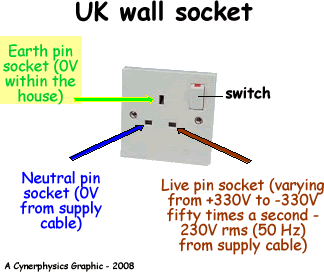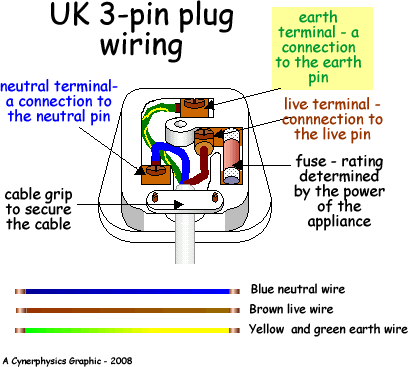|

The UK
mains supply is about 230 volts AC (RMS).
 The voltage is not a steady 230V. It varies sinusoidally with time at a frequency of 50Hz. The voltage is not a steady 230V. It varies sinusoidally with time at a frequency of 50Hz.
 for a diagram of voltage against time for mains electricity - you should
know this diagram. for a diagram of voltage against time for mains electricity - you should
know this diagram.
 Mains voltage can kill if it is not used
safely. Mains voltage can kill if it is not used
safely.
 to find out about the dangers. to find out about the dangers.
The Mains Supply is brought into the house via the main fuse box and is distributed around the house using cabling under the floorboards and within walls. Sockets are fitted so that the house occupiers can access the electricity supply easily and safely.
Most electrical appliances are connected
to the Mains using cable and a 3-pin plug. The 3-pin plug can then be plugged into the socket and make a connection with the Mains Supply.

A typical cable comprises of:
 two or three
inner cores of copper, because copper is a good conductor; two or three
inner cores of copper, because copper is a good conductor;
 outer
layers of flexible plastic, because plastic is a good insulator. outer
layers of flexible plastic, because plastic is a good insulator.
A plug has:
 a plastic or
rubber case, because plastic and rubber are good insulators; a plastic or
rubber case, because plastic and rubber are good insulators;
 connector
pins made from brass, because brass is a good conductor; connector
pins made from brass, because brass is a good conductor;
 a fuse (3A, 5A and 13A are the most common values); a fuse (3A, 5A and 13A are the most common values);
 an earth
pin; an earth
pin;
 a cable
(or cord) grip to hold the cable firmly in place and stop a user pulling
wires free from their correct connections. The other end of the cable is connected to the electrical circuit inside the appliance. a cable
(or cord) grip to hold the cable firmly in place and stop a user pulling
wires free from their correct connections. The other end of the cable is connected to the electrical circuit inside the appliance.
When connecting an appliance to a 3-pin
plug:
 the blue wire is connected to the neutral terminal; The neutral terminal stays
at a voltage close to zero (it tends to vary around zero at 50Hz with max and min close to zero volts) with respect to earth. It is 'earthed'
at the electricity sub-station. the blue wire is connected to the neutral terminal; The neutral terminal stays
at a voltage close to zero (it tends to vary around zero at 50Hz with max and min close to zero volts) with respect to earth. It is 'earthed'
at the electricity sub-station.
 the brown wire is
connected via a fuse to the live terminal; The live terminal of
the mains supply alternates sinusoidally between a positive and
negative voltage with respect to the neutral terminal. the brown wire is
connected via a fuse to the live terminal; The live terminal of
the mains supply alternates sinusoidally between a positive and
negative voltage with respect to the neutral terminal.
 the green/yellow
wire (when fitted) is connected to the earth terminal; the green/yellow
wire (when fitted) is connected to the earth terminal;
 the cable should
be secured in the plug by the cable grip; the cable should
be secured in the plug by the cable grip;
 a
fuse of the current value (rating) should be
in place. a
fuse of the current value (rating) should be
in place.
When provided with appropriate diagrams you
should be able to:
 recognise
errors in the wiring of a mains (3-pin) plug; recognise
errors in the wiring of a mains (3-pin) plug;
 recognise
dangerous practice in the use of mains electricity. recognise
dangerous practice in the use of mains electricity.
 Try the 'wiring a plug' crossword Try the 'wiring a plug' crossword
|





 Try the 'wiring a plug' crossword
Try the 'wiring a plug' crossword



 The voltage is not a steady 230V. It varies sinusoidally with time at a frequency of 50Hz.
The voltage is not a steady 230V. It varies sinusoidally with time at a frequency of 50Hz.

